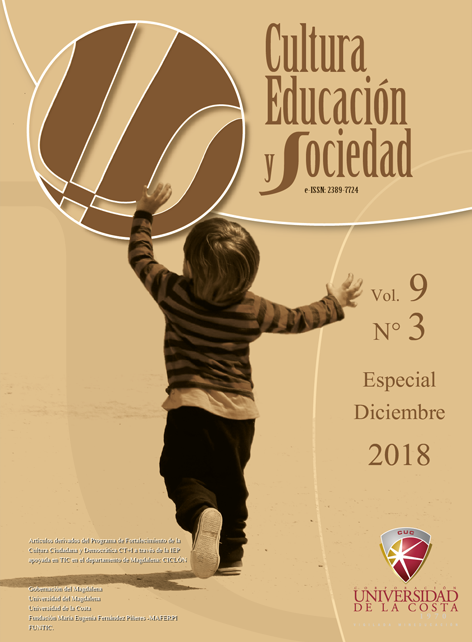Group dynamics as a pedagogical strategy supported by information and communication technologies to strengthen values
DOI:
https://doi.org/10.17981/cultedusoc.9.3.2018.11Keywords:
Healthy coexistence, Tics, group dynamics.Abstract
Group dynamics has been a strategy that, together with the use of information and communication technologies, contributes to education processes, in terms of teaching values and strengthening school coexistence. The present study corresponds to strengthen the healthy coexistence and teaching of values through group dynamics in elementary students of the Departmental Educational Institute (IED) of San José de San Fernando. The Research is based on the Participation Action (IAP), it allows to generate knowledge jointly for the elaboration of the school garden to the members of the educational community. Students consider it necessary to propose and consolidate standards of healthy coexistence that are known to all students, teachers and managers. There is evidence of the need to address conflicts in time and motivate them to resolve them without violence, fostering the positive impact generated by the participation of parents in the education of their children.
Downloads
References
Banz, C. (2008). Las dinámicas grupales: una técnica de aprendizaje. Chile: Educarchie. Recuperado de: http://ww2.educarchile.cl/UserFiles/P0037/File/Formacion/Formacion_Integral%2006.pdf
Carrasco, A. (2009). ¿Cómo evaluar la convivencia escolar? La mirada desde los estudiantes?. Revista Iberoamericana de evaluación educativa, 2 (1), 258-271.
De la cruz, M. (2015). Dinámicas grupales [Mensaje en un blog]. Recuperado de: http://dinamicasgrupalesenf.blogspot.com.co/2015/11/dinamicas-grupales.html
García, T. (2003). El cuestionario como instrumento de investigación/evaluación. Recuperado de: http://www.univsantana.com/sociologia/El_Cuestionario.pdf
López de Mesa-Meloa, C., Carvajal-Castillob, C., Soto-Godoyc, M., y Urrea-Roa, P. (2013). Factores asociados a la convivencia escolar en adolescentes. Educ.educ, 16 (3). Recuperado de: http://www.scielo.org.co/scielo.php?script=sci_arttext&pid=S0123-12942013000300001
Montoya, W., Vanegas, A., y Mejía, L. (2016). La evaluación como proceso para la autorregulación de los aprendizajes en el área de ciencias sociales (Tesis de pregado). Recuperado de: http://ayura.udea.edu.co:8080/jspui/bitstream/123456789/2343/1/PB01015_Anacarovanegas_wilmarmontoya.pdf
Nail, O., Muñoz, M., y Gajardo, J. (2013). Principios orientadores de la convivencia en el aula: una estrategia de reflexión colectiva. Educ. Pesqui, 39 (2), 367-385.
Núñez Flórez, E., Vergara Ortiz, R., & Bocanegra García, J. (2014). Sistema experto basado en lógica difusa tipo 1 para determinar el grado de riesgo de preeclampsia. INGE CUC, 10(1), 43-50. Recuperado a partir de https://revistascientificas.cuc.edu.co/ingecuc/article/view/341
Olivares, S., Villón, O., y Iliana, C. (2011). Diseño de estrategias mediadoras de conflictos escolares, para mejorar la convivencia educativa en los estudiantes de la Escuela Virgilio Drouet Fuentes, ubicada en el cantón Santa Elena, durante el año 2010-2011. La Libertad. UPSE. Matriz: Facultad de Ciencias de la Educación e Idiomas. 108p.
Patiño Builes, A. (2015). Tendencias tecnológicas que influyen en el aumento de la productividad empresarial. INGE CUC, 11(2), 84-96. https://doi.org/10.17981/ingecuc.11.2.2015.09
Quiroz, R., y Saco, S. (2000). Factores asociados al síndrome burnout en médicos y enfermeras del hospital nacional sur este de essalud del Cusco. SITUA - Revista Semestral de la Facultad de Medicina Humana – UNSAAC, 11-22.
Romagnolí, C., Mena, I., y Valdez, A. (2006). ¿Qué son las habilidades socio afectivas y éticas?. Recuperado de: http://ww2.educarchile.cl/UserFiles/P0037/File/Formacion/Formacion_Integral%2003.pdf
Tello, N. (2005). “Comunidad Segura: modelo de trabajo social para intervenir en el problema de la inseguridad pública” en Trabajo Social (revista de la ENTS-UNAM).
Villalobos, C., Peña, J., Aguirre, E., y Guerrero, M. (2017). Liderazgo escolar y conflictos socioeducativos. Un estudio exploratorio en liceos públicos chilenos. Calidad en la educación, 47, 81-111.
Downloads
Published
How to Cite
Issue
Section
License
Copyright (c) 2018 CULTURA EDUCACIÓN Y SOCIEDAD

This work is licensed under a Creative Commons Attribution-NonCommercial-NoDerivatives 4.0 International License.
![]()
Creative Commons 2020 CULTURA EDUCACIÓN Y SOCIEDAD
This article is under international license Creative Commons Reconocimiento-NoComercial-SinObrasDerivadas 4.0.
The published articles are the sole responsibility of their authors and do not necessarily reflect the opinions of the editorial committee.
CULTURA EDUCACIÓN Y SOCIEDAD respects the moral rights of its authors, who assign to the editorial committee the patrimonial rights of the published material. In turn, the authors inform that this work is unpublished and has not been previously published.
All articles are under a:
Licencia Creative Commons Atribución-NoComercial-SinDerivadas 4.0 Internacional.
![]()


 English
English
 Español (España)
Español (España)




_12.53_.27_p_. m_._3.png)





_12.57_.35_p_. m_._3.png)
_12.50_.37_p_. m_._3.png)



